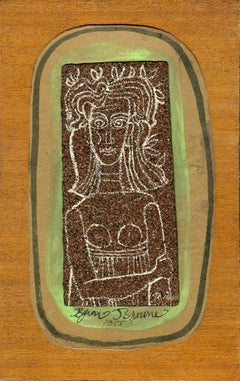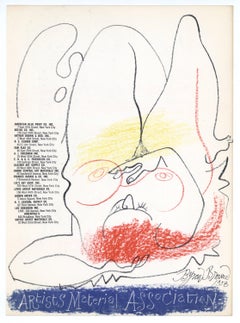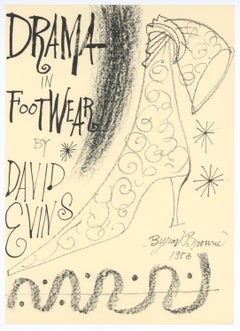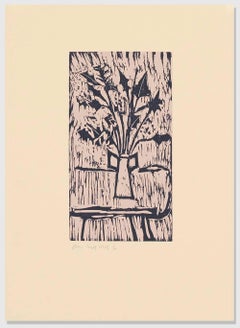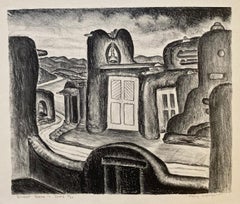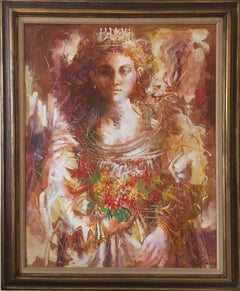Byron Browne Art
American, 1907-1961
Byron Browne (1907-1961) was an American painter and founding member of the American Abstract Artists.
Browne was born on June 26, 1907 in Yonkers, New York. He studied at the National Academy of Design from 1925 to 1928. He was a member of the Artists Union. In 1936 he was one of the founding members of the American Abstract Artists. He created murals under the auspices of the Works Progress Administration for the Chronic Disease Hospital and the 1939 New York World's Fair. In 1940 he married fellow artist Rosalind Bengelsdorf. He taught painting at the Art Students League of New York from 1948 through 1959 and went on to teach at New York University. He died on December 25, 1961 in New York City.
Browne's work is included in the collections of the Art Institute of Chicago,[5] the Museum of Modern Art, the Philadelphia Museum of Art, the Smithsonian American Art Museum, and the Whitney Museum of American Art.(Biography provided by Graves International Art)
to
3
23
8
20
3
11
2
7
3
Overall Height
to
Overall Width
to
10
4
16
11
7
7
4
4
3
3
2
2
2
2
2
1
1
1
1
1
1
1
23
1
5
13
1
23
6,898
3,229
2,514
1,217
11
8
8
6
5
Artist: Byron Browne
Woman with Arms Crossed
By Byron Browne
Located in Fairlawn, OH
Woman with Arms Crossed
Mixed media collage-painting on stone chip surface, mounted on fabric, mounted on wood support by the artist, 1955
Signed and dated lower center
Image size: 1...
Category
1950s American Modern Byron Browne Art
Materials
Other Medium
original lithograph
By Byron Browne
Located in Henderson, NV
Medium: original lithograph. This lithograph was printed for the inside back cover of the 1958 "Improvisations" portfolio, published by the Artists Equity Association of New York on ...
Category
1950s Byron Browne Art
Materials
Lithograph
original lithograph
By Byron Browne
Located in Henderson, NV
Medium: original lithograph. This lithograph was printed in 1958 for the "Improvisations" portfolio, published by the Artists Equity Association of New York on the occasion of the 19...
Category
1950s Byron Browne Art
Materials
Lithograph
original lithograph
By Byron Browne
Located in Henderson, NV
Medium: original lithograph. This lithograph was printed in 1956 for the "Improvisations" portfolio, published by the Artists Equity Association of New York on the occasion of the 19...
Category
1950s Byron Browne Art
Materials
Lithograph
original lithograph
By Byron Browne
Located in Henderson, NV
Medium: original lithograph. This lithograph was printed in 1957 for the "Improvisations" portfolio, published by the Artists Equity Association of New York on the occasion of the 19...
Category
1950s Byron Browne Art
Materials
Lithograph
original lithograph
By Byron Browne
Located in Henderson, NV
Medium: original lithograph. This lithograph was printed in 1957 for the "Improvisations" portfolio, published by the Artists Equity Association of New York on the occasion of the 19...
Category
1950s Byron Browne Art
Materials
Lithograph
On the Beach modernist oil painting by Byron Browne
By Byron Browne
Located in Hudson, NY
Byron Browne
On the Beach (1959)
Oil on canvas, 20" x 26"
26" x 32" x 1" frame size - likely original
Inscribed verso "On the Beach / 1959 / Byron Browne"
Provenance: Private collection, Berkley, California
About this artist: Through an oeuvre displaying the re-envisioning of figural subjects and the formation of an abstract expressionist style, Byron Browne stands out among the American abstractionists of his generation. Born in Yonkers, New York, in 1907, the artist was a bright talent at the National Academy of Design in his teens. From 1924 to 1928 Browne studied at the Academy under notable artists Robert Aitkin, Charles Courtney Curran, Charles Hawthorne, Alice Murphy...
Category
Mid-20th Century Modern Byron Browne Art
Materials
Oil, Canvas
Folk Singer oil painting by Byron Browne
By Byron Browne
Located in Hudson, NY
Lovely oil painting by Byron Browne. Measures 18" x 14" and framed 24" x 20" x 1 3/4".
Signed "Byron Browne" lower left.
Inscribed on canvas verso: Byron Browne / 1958 / – Folk Singer– / 18 x 14 / N.Y.C.
About this artists: Through an oeuvre displaying the re-envisioning of figural subjects and the formation of an abstract expressionist style, Byron Browne stands out among the American abstractionists of his generation. Born in Yonkers, New York, in 1907, the artist was a bright talent at the National Academy of Design in his teens. From 1924 to 1928 Browne studied at the Academy under notable artists Robert Aitkin, Charles Courtney Curran, Charles Hawthorne, Alice Murphy...
Category
1950s Modern Byron Browne Art
Materials
Oil, Canvas
Neoclassical Head in profile
By Byron Browne
Located in Fairlawn, OH
Neoclassical Head in profile
Watercolor and graphite on paper, 1950
Signed and dated lower left in ink (see photo)
Provenance: Washington, D.C. priva...
Category
1950s Modern Byron Browne Art
Materials
Watercolor
Two Heads -- 1947
By Byron Browne
Located in Washington, DC
Byron Browne was an important American modernist painter.
Ink, tempera, and crayon on paper
Signed and dated lower right.
Category
1940s American Modern Byron Browne Art
Materials
Paper, Mixed Media
Mother and Child -- 1949
By Byron Browne
Located in Washington, DC
Bryon Browne was an important American modernist painter.
Signed upper right; signed, dated and situated 'New York' on reverse
Category
1940s American Modern Byron Browne Art
Materials
Canvas, Oil
original lithograph
By Byron Browne
Located in Henderson, NV
Medium: original lithograph. This lithograph is from the rare 1954 "Improvisations" portfolio, published by the Artists Equity Association of New York on the occasion of the 1954 Spr...
Category
1950s Byron Browne Art
Materials
Lithograph
original lithograph
By Byron Browne
Located in Henderson, NV
Medium: original lithograph. This lithograph is from the rare 1954 "Improvisations" portfolio, published by the Artists Equity Association of New York on the occasion of the 1954 Spr...
Category
1950s Byron Browne Art
Materials
Lithograph
The Night Journey - Drip Painting like Jackson Pollock
By Byron Browne
Located in Miami, FL
In Byron Brown's "The Night Journey", 1947, Picasso meets Jackson Pollock. Here Brown strikes a balance between fanciful representation and abstraction. ...
Category
1940s Abstract Expressionist Byron Browne Art
Materials
Canvas, Oil
Byron Browne, (Abstraction)
By Byron Browne
Located in New York, NY
This print was made for the American Abstract Artists Portfolio, 1937. All the images were lithographs made on zinc plates. Usually they were signed in the image -- on the plate, as ...
Category
1930s Abstract Byron Browne Art
Materials
Lithograph
"Nude by the Mirror" Mid-Century Modern Expressionist and Cubist Figure
By Byron Browne
Located in New York, NY
Byron Browne (1907 - 1961)
Nude by a Mirror, 1958
Oil on canvas
26 x 20 inches
Signed lower right
Provenance:
Doyle New York, Doyle + Design, June 7, 2017, Lot 20
Born in Yonkers,...
Category
1950s American Modern Byron Browne Art
Materials
Oil, Canvas
Seated Nude with Mirror /// Figurative Chair Lady Woman Byron Browne Drawing Art
By Byron Browne
Located in Saint Augustine, FL
Artist: Byron Browne (American, 1907-1961)
Title: "Seated Nude with Mirror"
*Signed and dated by Browne in pencil lower right
Year: 1957
Medium: Original Graphite Pencil Drawing on u...
Category
1950s Modern Byron Browne Art
Materials
Pencil, Graphite
Provincetown Beach (abstract seascape painting)
By Byron Browne
Located in Wilton Manors, FL
Byron Browne (1907-1961). Provincetown Beach, 1957. Oil on canvas, 24 x 30 inches, 30 x 36 inches in vintage solid chestnut frame. Signed lower righ...
Category
Mid-20th Century Abstract Byron Browne Art
Materials
Linen, Oil
Seated Nude, Pastel and Watercolor by Byron Browne
By Byron Browne
Located in Long Island City, NY
Artist: Byron Brown (American 1907 - 1961)
Title: Seated Nude
Year: 1957
Medium: Pastel and Watercolor on Paper, signed and dated l.r.
Size: 25.5 x 19.5 in...
Category
1950s American Modern Byron Browne Art
Materials
Watercolor, Pastel
Sousaphone Player in Marching Band, Modern Print by Byron Browne
By Byron Browne
Located in Long Island City, NY
Artist: Byron Browne (after), American (1907 - 1961)
Title: Sousaphone Player in Marching Band
Year: circa 1940
Medium: Collotype, signed in the plate
Image Size: 26.5 x 20.5 in. (67...
Category
1940s American Modern Byron Browne Art
Materials
Offset
Fauvist Post Impressionist Provincetown Beach on FLAG DAY
By Byron Browne
Located in New York, NY
Wonderful Fauvist Post Impressionist Provincetown Beach on FLAG DAY by Byron Browne (1907-1961). Oil on Canvas, dated 1956. Signed lower right. D...
Category
Mid-20th Century Abstract Impressionist Byron Browne Art
Materials
Oil
UNTITLED PORTRAIT (Self Portrait?)
By Byron Browne
Located in Portland, ME
Browne, Byron (American, 1907-1961).
UNTITLED PORTRAIT (Self Portrait?). watercolor and pencil, 1942.
Signed and dated, lower right.
14 x 11 inches. Matted to 20 x 16 inches
In e...
Category
1940s Byron Browne Art
Materials
Watercolor
Clown
By Byron Browne
Located in New York, NY
Oil on panel
Signed and dated, l.l.
This artwork is offered by ClampArt, located in New York City.
Category
1960s Other Art Style Byron Browne Art
Materials
Panel, Oil
Related Items
Still Life
By Alex Katz
Located in New York, NY
Still life woodcut and lithograph on Rives Creme paper.
Category
21st Century and Contemporary Contemporary Byron Browne Art
Materials
Woodcut, Lithograph
Mary Lightfoot, Street Scene in Taos
Located in New York, NY
Mary Lightfoot was born in Ravenna, Texas. She studied at the College of Industrial Arts in Denton and the North Texas State Teachers College prior to receiving a master of arts degree from Columbia University. Her entire teaching career was with the Dallas Public School system; she summered in Europe...
Category
Mid-20th Century American Modern Byron Browne Art
Materials
Lithograph
Chen Quian. Advertisement for B.S Insurance Co
Located in New York, NY
Artist: Chen Quian.
[Advertisement for B.S Insurance Co.] 1912
Color lithograph, Rare. Very early Chinese advertising poster at the end of the
Qu...
Category
1910s Qing Byron Browne Art
Materials
Lithograph
Philip Cheney, April Thaw
Located in New York, NY
This peaceful, idyllic scene is a perfect example of works published by Associated American Artists in the 1940s -- an American subject, drama-free, and masterfully drawn. It was iss...
Category
Mid-20th Century American Modern Byron Browne Art
Materials
Lithograph
Six O'Clock
Located in Los Angeles, CA
Six O-Clock, c. 1942, oil on canvas, 30 x 20 inches, signed and titled several times verso of frame and stretcher (perhaps by another hand), marked “Rehn” several times on frame (for the Frank K. M. Rehn Galleries in New York City, who represented Craig at the time); Exhibited: 1) 18th Biennial Exhibition of Contemporary American Oil Paintings from March 21 to May 2, 1943 at The Corcoran Gallery of Art in Washington, D.C. #87, original price $450 (per catalog) (exhibition label verso), 2) Craig’s one-man show at the Frank K. M. Rehn Galleries, New York City, from October 26 to November 14, 1942, #10 (original price listed as $350); and 3) Exhibition of thirty paintings sponsored by the Harrisburg Art Association at the State Museum of Pennsylvania in Harrisburg in March, 1944 (concerning this exhibit, Penelope Redd of The Evening News (Harrisburg, Pennsylvania) wrote: “Other paintings that have overtones of superrealism inherent in the subjects include Tom Craig’s California nocturne, ‘Six O’Clock,’ two figures moving through the twilight . . . .” March 6, 1944, p. 13); another label verso from The Museum of Art of Toledo (Ohio): original frame: Provenance includes George Stern Gallery, Los Angeles, CA
About the Painting
Long before Chris Burden’s iconic installation outside of the Los Angeles County Museum of Art, Urban Light, another artist, Tom Craig, made Southern California streetlights the subject of one of his early 1940s paintings. Consisting of dozens of recycled streetlights from the 1920s and 1930s forming a classical colonnade at the museum’s entrance, Burden’s Urban Light has become a symbol of Los Angeles. For Burden, the streetlights represent what constitutes an advanced society, something “safe after dark and beautiful to behold.” It seems that Craig is playing on the same theme in Six O-Clock. Although we see two hunched figures trudging along the sidewalk at the end of a long day, the real stars of this painting are the streetlights which brighten the twilight and silhouette another iconic symbol of Los Angeles, the palm trees in the distance. Mountains in the background and the distant view of a suburban neighborhood join the streetlights and palm trees as classic subject matter for a California Scene painting, but Craig gives us a twist by depicting the scene not as a sun-drenched natural expanse. Rather, Craig uses thin layers of oil paint, mimicking the watercolor technique for which he is most famous, to show us the twinkling beauty of manmade light and the safety it affords. Although Southern California is a land of natural wonders, the interventions of humanity are already everywhere in Los Angeles and as one critic noted, the resulting painting has an air of “superrealism.”
About the Artist
Thomas Theodore Craig was a well-known fixture in the Southern California art scene. He was born in Upland California. Craig graduated with a degree in botany from Pomona College and studied painting at Pamona and the Chouinard Art School with Stanton MacDonald-Wright and Barse Miller among others. He became close friends with fellow artist Milford Zornes...
Category
1940s American Modern Byron Browne Art
Materials
Canvas, Oil
Refreshment and Intermission
Located in Los Angeles, CA
This painting is part of our exhibition America Coast to Coast: Artists of the 1930s
Refreshment and Intermission, tempera on board, 11 x 19 inches, c. 1930/40s, signed lower middle, exhibited at Groom's one person show at Closson’s Gallery, Cincinnati, OH, March, 1943 (see The Cincinnati Enquirer, March 7, 1943, section 3, p. 4); provenance includes a private Ohio collection; presented in a period gold painted frame
About the Painting
Refreshment and Intermission is part of a series of paintings of Amish subjects Grooms started in 1938 based on his travels in Pennsylvania. These tempera works reflect the Regionalist impulse to paint local scenes far away from big cities. Focusing on both people and landscape, Grooms' compositions tell the stories of the uniquely American experience of the Amish. “Grooms paints the Amish people with as much understanding of type and appreciation of the plastic quality as any artist who has approached this challenging subject," noted the art critic for The Cincinnati Inquirer when reviewing Grooms' solo exhibition at Closson' Gallery, "In his current show, ‘Refreshment and Intermission,’ is a case in point. Here the absorbed concentration of people eating is described without an ounce of sentimentality. He has made the most of the interest between groups and of the conversations, both humorous and serious. The work has the quaint simplicity of a Lord’s Supper...
Category
1930s American Modern Byron Browne Art
Materials
Tempera
Gold Mine, Central City, Colorado
By Joseph Meert
Located in Los Angeles, CA
This painting is part of our exhibition America Coast to Coast: Artists of the 1930s
Goldmine, Central City, Colorado, oil on canvas, 36 x 28 inches, c. 1936, signed lower right, ex collection of Platt Fine Art, Chicago, Illinois (label verso).
About the Painting
Joseph Meert’s painting, Goldmine, Central City, Colorado, depicts the short-lived resurrection of a once prominent city just outside Denver. Central City was founded in 1859 soon after John Gregory struck gold in the area. As word spread, thousands of miners converged into “Gregory’s Gulch” and its surroundings became known as the “richest square mile on earth.” Mining production quickly increased resulting in Central City to becoming Colorado’s largest city in the early 1860s. Despite some technical difficulties transitioning to lode mining and the rise of competition from Leadville, Central City remained an economic boom town through the turn of the century. But, with every boom, there is a bust. World War I marked the end of Central City’s prominence as ore production ground to a halt and by 1925, the town’s population shrank to only 400 people. The desperation of the Great Depression and a nearly 100% increase in the price of gold lured labor and capital back to Central City. Meert painted in Colorado during the mid-1930s, a time when he created his most desirable works. It is during this period of renaissance that Meert captures one of Central City's outlying dirt streets bordered by 19th century wooden houses from the town's heyday and the more recently installed electric lines leading to a distant gold mine. A lone figure trudges up the hill, a mother with a baby in her arms, putting us in mind of the rebirth of the town itself. Meert had solo exhibitions at the Colorado Springs Fine Arts Center in 1936 and the Denver Art Museum. Although it is not known whether Goldmine, Central City was included in either of these exhibitions, it seems likely. Moreover, the painting is closely related to Meert’s painting, The Old Road, which was painted in 1936 and exhibited at the Corcoran Gallery of Art in Washington, DC and at the Dallas Museum of Art.
About the Artist
Joseph Meert was a well-regarded painter and muralist, who initially made a name for himself in the American Scene and later as an abstract expressionist. Although initially successful, Meert struggled financially and with mental illness later in life. He was born in Brussels, Belgium, but moved with his family to Kansas City, Missouri. As a child, a chance encounter at the Union Pacific Railyard changed his life. Meert happened upon a worker repainting and stenciling a design on a railroad car. Meert later recalled that this experience introduced him to the idea of being a painter. Without support from his father, Meert obtained a working scholarship to the Kansas City Art Institute. After four years at the Kansas City Art Institute, Meert studied seven years at the Art Students League and in Europe and Los Angeles. At the Art Students League, Meert fell under the spell of Thomas Hart Benton and Stanton MacDonald-Wright. In 1931, he befriended Jackson Pollock. By 1934, Meert was part of the Public Works of Art Project when he met his wife, Margaret Mullin...
Category
1930s American Modern Byron Browne Art
Materials
Oil, Canvas
Redman Dorgeloh, Octagon House (San Francisco, CA)
By Redman Dorgeloh
Located in New York, NY
This print was made in an edition of 25 for the California WPA. It is signed and titled in pencil. The artist's full name was Marguerite Redmond Dorgeloh and that is the way this pri...
Category
Mid-20th Century Ashcan School Byron Browne Art
Materials
Lithograph
Edward Sacks, Seated Figure
Located in New York, NY
Little is known about the artist, Edward (Ed) Sacks, although this print may have been made at the Art Students League in NYC.
it is a cross between, as the title suggests, a Seated ...
Category
1940s American Modern Byron Browne Art
Materials
Lithograph
San Pedro Post Office: History of Writing Mural South, Preliminary Mural Study
Located in Los Angeles, CA
This mural study is part of our exhibition America Coast to Coast: Artists of the 1930s
San Pedro Post Office: History of Writing Mural South, Preliminary Mural Maquette right panel...
Category
1930s American Modern Byron Browne Art
Materials
Mixed Media
The Demogogue
Located in Los Angeles, CA
The Demagogue or Tale in a Tub, 1952, oil on canvas, 20 x 24 inches, signed, titled, and dated verso
About the Painting
The Demagogue is an iconic Bendor Mark painting from the prime of his post-war period. Beginning early in his career, Mark was fascinated with depictions of the human figure and their capacity to tell stories of the world around him. Mark was a keen observer of his times and in The Demagogue we see Mark’s portrayal of a faithless politician holding up a “V” for victory sign as he appeals to the wanton desires and prejudices of the masses. Below the demagogue is a swirl of humanity representing the common man who is being pushed down by the powerful, while the robed figure of liberty with her scales of justice held high is brushed aside. Behind the demagogue, Mark places two other powerful supporting institutions which were often co-opted by the world’s dictators, the Church and the Military. Mark was an internationalist, so it is difficult to know exactly which demagogue inspired him to create this work, but in 1952 there were many to choose from. Whether depicting Argentina’s Peron (the demagogue and the women to the right resemble Juan and Eva Peron), Spain’s Franco or the United States’ homegrown fear mongers like Joseph McCarthy, Mark tells a universal story that unfolded in dramatic fashion during the post-war period as nations and their peoples grappled with authoritarianism and anti-democratic impulses. Stylistically, The Demagogue draws on the elements which make Mark’s work from this period immediately recognizable, a saturated palette, a closely packed and frenetic composition, exaggerated figuration and stylized facial features. But, above all, we see Mark’s ability to tell the stories of the rich and powerful and their ability to oppress. Like Mark’s work in the collection of the Whitney Museum of American Art (The Hourglass - 1950-51) and the Los Angeles County Museum of Art (Execution – 1940), The Demagogue pulls no punches, as the artist lays bare the threats to freedom and basic human rights.
About the Artist
Bendor Mark was an American modernist and social realist painter. Born as Bernard Marcus on June 5, 1912, in Brooklyn, New York, Mark trained at The Cooper Union during the 1920s where he studied with William Brantley van Ingen and became a prize-winning artist with a focus on painting the human figure. After his time at Cooper, Mark continued to live in New York and worked as a commercial artist and textile designer in addition to his pursuit of a career in painting. Like many Depression Era artists, Mark engaged with social progressives and in 1934, he joined the Artist’s Union which had the goal of advancing artists’ position as “worker.” Mark’s painting, Restaurant, which is now in the permanent collection of the Smithsonian American Art Museum, appeared in the February 1936 edition of the Union’s publication, Art Front, as part of a review of an exhibition at ACA Gallery in New York.
Mark worked on the Federal Art Project and by the mid- to late-1930s, began a series of paintings exploring the working conditions and hazards of the mining industry. Mark believed that miners were “in the forefront of the struggle for emancipation” and that the mere “struggle for existence is like moving mountains.” He became passionate about the Spanish Civil War and painted sympathetic images in support of the Spanish Republic. Mark was a premature anti-fascist and throughout his career painted works critical of dictators and other oppressors. During the late 1930s, Mark entered mural competitions with designs influenced by the Mexican muralists, taught adult art education in Queens, New York, and was an instructor at the WPA’s Queensboro Art Center. He was so committed to socially progressive art that by 1934, he had changed his name to Bendor Mark, in part, to distinguish his social realist paintings from his earlier work.
During World War II, Mark worked as an artist for military contractors. After the war, he was employed as a graphic artist and in the printing industry before moving to Southern California in 1948, where he returned to a fine art practice the following year with politically and socially charged images which reflected his view of the shortcomings of the post-War period, the continued threat of fascism, and the international tensions of the Cold War. As the mood of the country shifted towards the right during the McCarthy Era and the art world’s attention focused on abstraction at the expense of figuration, Mark’s career as a painter suffered.
From the 1950s through the 1980s, Mark continued to depict the events that shaped the world around him, often employing a highly stylized approach characterized by dynamic multi-figure compositions, a subtle muted palette, and exaggerated expressive features. A review of Mark’s oeuvre suggests that few people escaped Mark’s attention. He painted presidents, prime ministers, royalty, evangelists, musicians, and dictators (and their henchman), along with miners, farm workers, the urban poor, protesters, the unemployed and dispossessed. He laid bare the arrogance, cruelty, and hypocrisy of the world’s elites. Mark noted, “A work of art cannot be fully appreciated or wholly understood without considering the socio-political and cultural ambience that gave it birth.” He continued, “I have the ability to foresee the direction of social and political events while they are actually taking place.” He was not himself a direct political activist, however. Although Mark commented, “It’s a misconception to separate art from the social aspect of life,” he viewed artists as being neutral. According to Mark, “An apolitical attitude reflects the fact that the artist is passive. . . An artist never affects society; he merely reflects it.”
In addition to the Mexican Muralists, Mark was influenced by the old masters Rembrandt, Michelangelo, and Masaccio, as well as the more modern master, Van Gogh. Mark’s writings directly acknowledge these influences and archival material from his estate includes magazine articles, pamphlets and transparencies related to these artists. Mark also collected materials related to several of his social realist contemporaries, including Reginald Marsh, Ben Shahn, Leonard Baskin, and Raphael Soyer, who was Mark’s good friend. For years, Soyer sent Mark holiday cards and Soyer inscribed a message of friendship on a self-portrait he gifted to Mark in the 1970s, all of which are still held in the collection of Mark’s family.
From the late 1920s through the mid-1950s, Mark’s work was well received. His paintings won prizes and were accepted into major juried exhibitions including at the Brooklyn Museum, the New York World’s Fair and the Metropolitan Museum of Art. He gained national recognition for paintings depicting the oppressed and the common worker. Despite the decline in popularity of representational art during the 1950s and 1960s, Mark stayed true to his interest in depicting the human figure and by the last two decades of his life, his work underwent a reassessment as curators included Mark’s paintings in exhibitions showcasing the role of labor in art during the Depression Era. This recognition continued in recent years when Mark was honored by having his work included in the Whitney Museum of American Art’s ground-breaking exhibition, Vida Americana, which explored the pioneering role that the Mexican muralists played in the development of modern American art during the inter-war period. The influence of Rivera, Siqueiros and Orozco on Mark is unmistakable and his paintings from the 1950s (and beyond) sit comfortably in dialogue with other Los Angeles artists who continued to paint in the social realist tradition long after the mainstream art world had moved toward abstraction. Mark’s concern for underserved Brown and Black communities was shared with artists such as Charles White and his ally, Edward Biberman...
Category
Mid-20th Century American Modern Byron Browne Art
Materials
Oil, Canvas
Nude with Drape
By Fletcher Martin
Located in Los Angeles, CA
Nude with Drape, c. 1937, oil on board, 24 x 17 (oval), signed lower right, provenance: Frances Lee Kent Falcone Family Trust
About the Painting
Fletcher Martin’s Nude with Drape ...
Category
1930s American Modern Byron Browne Art
Materials
Oil
Previously Available Items
“Picador and the Bull”
By Byron Browne
Located in Southampton, NY
Here for your consideration is one of the final mixed media paintings done by Byron Browne in the year he died. Signed and dated middle bottom, 1961. Condition is excellent. The ar...
Category
1960s Post-Modern Byron Browne Art
Materials
Archival Paper, Ink, Watercolor
Primavera
By Byron Browne
Located in Los Angeles, CA
BYRON BROWNE
"PRIMAVERA"
OIL ON CANVAS, SIGNED
AMERICAN, C.1950
38 X 30 INCHES
Byron Browne's artistic training was conventional, and little about his career at the National Aca...
Category
1950s Surrealist Byron Browne Art
Materials
Canvas, Oil
untitled (acrobat juggling balls with a tuba)
By Byron Browne
Located in Fairlawn, OH
Signed and dated lower right in ink
Category
1940s Abstract Byron Browne Art
Materials
Crayon, Ink, Mixed Media, Watercolor, Felt Pen
Byron Browne art for sale on 1stDibs.
Find a wide variety of authentic Byron Browne art available for sale on 1stDibs. You can also browse by medium to find art by Byron Browne in paint, oil paint, fabric and more. Much of the original work by this artist or collective was created during the 20th century and is mostly associated with the modern style. Not every interior allows for large Byron Browne art, so small editions measuring 6 inches across are available. Customers who are interested in this artist might also find the work of Thomas Hart Benton, Leon Kelly, and Charles Ragland Bunnell. Byron Browne art prices can differ depending upon medium, time period and other attributes. On 1stDibs, the price for these items starts at $75 and tops out at $65,000, while the average work can sell for $3,500.
